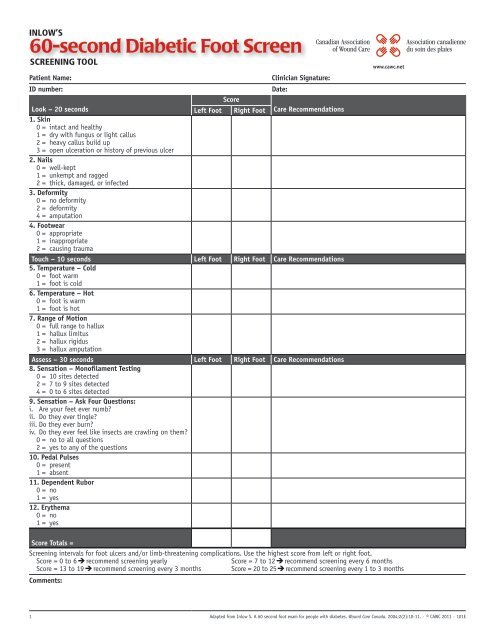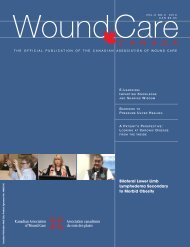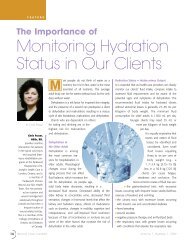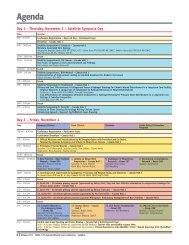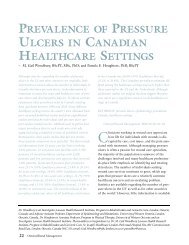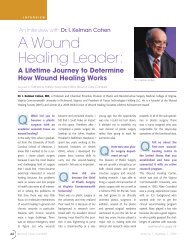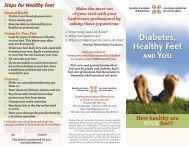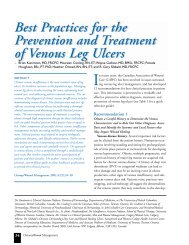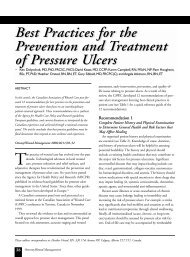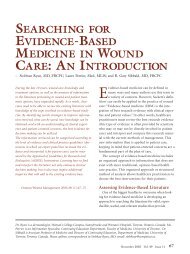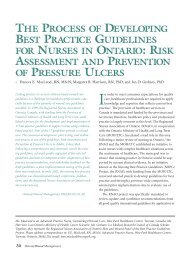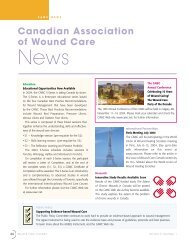Inlow's 60-Second Diabetic Foot Screen Tool
Inlow's 60-Second Diabetic Foot Screen Tool
Inlow's 60-Second Diabetic Foot Screen Tool
Create successful ePaper yourself
Turn your PDF publications into a flip-book with our unique Google optimized e-Paper software.
inlow’S<br />
<strong>60</strong>-second <strong>Diabetic</strong> <strong>Foot</strong> <strong>Screen</strong><br />
<strong>Screen</strong>ing <strong>Tool</strong><br />
Patient Name: Clinician Signature:<br />
ID number: Date:<br />
Look – 20 seconds<br />
1. Skin<br />
0 = intact and healthy<br />
1 = dry with fungus or light callus<br />
2 = heavy callus build up<br />
3 = open ulceration or history of previous ulcer<br />
2. Nails<br />
0 = well-kept<br />
1 = unkempt and ragged<br />
2 = thick, damaged, or infected<br />
3. Deformity<br />
0 = no deformity<br />
2 = deformity<br />
4 = amputation<br />
4. <strong>Foot</strong>wear<br />
0 = appropriate<br />
1 = inappropriate<br />
2 = causing trauma<br />
Left <strong>Foot</strong><br />
Score<br />
Right <strong>Foot</strong> Care Recommendations<br />
Touch – 10 seconds<br />
5. Temperature – Cold<br />
0 = foot warm<br />
1 = foot is cold<br />
6. Temperature – Hot<br />
0 = foot is warm<br />
1 = foot is hot<br />
7. Range of Motion<br />
0 = full range to hallux<br />
1 = hallux limitus<br />
2 = hallux rigidus<br />
3 = hallux amputation<br />
Left <strong>Foot</strong> Right <strong>Foot</strong> Care Recommendations<br />
Assess – 30 seconds<br />
8. Sensation – Monofilament Testing<br />
0 = 10 sites detected<br />
2 = 7 to 9 sites detected<br />
4 = 0 to 6 sites detected<br />
9. Sensation – Ask Four Questions:<br />
i. Are your feet ever numb?<br />
ii. Do they ever tingle?<br />
iii. Do they ever burn?<br />
iv. Do they ever feel like insects are crawling on them?<br />
0 = no to all questions<br />
2 = yes to any of the questions<br />
10. Pedal Pulses<br />
0 = present<br />
1 = absent<br />
11. Dependent Rubor<br />
0 = no<br />
1 = yes<br />
12. Erythema<br />
0 = no<br />
1 = yes<br />
Left <strong>Foot</strong> Right <strong>Foot</strong> Care Recommendations<br />
www.cawc.net<br />
Score Totals =<br />
<strong>Screen</strong>ing intervals for foot ulcers and/or limb-threatening complications. Use the highest score from left or right foot.<br />
Score = 0 to 6 recommend screening yearly Score = 7 to 12 recommend screening every 6 months<br />
Score = 13 to 19 recommend screening every 3 months Score = 20 to 25 recommend screening every 1 to 3 months<br />
Comments:<br />
1 Adapted from Inlow S. A <strong>60</strong> second foot exam for people with diabetes. Wound Care Canada. 2004;2(2):10-11. · © CAWC 2011 · 101E
Instructions for Use<br />
General Guidelines: This tool is designed to assist in screening persons with diabetes to prevent or treat diabetes-related foot ulcers and/or limbthreatening<br />
complications. The screen should be completed on admission of any person with diabetes and then repeated as directed by risk and clinical<br />
judgment. Do not confuse patient visits with patient screening. Your patient may require frequent and regular visits for routine care but complete the<br />
screening as indicated or as relevant based on clinical judgment.<br />
Specific Instructions:<br />
Step 1: Explain screening to the patient and have them remove their shoes, socks from both feet.<br />
Step 2: Remove any dressings or devices that impair the screening.<br />
Step 3: Review each of the parameters for each foot as listed in the Inlow’s <strong>60</strong>-second <strong>Diabetic</strong> <strong>Foot</strong> <strong>Screen</strong> and select the appropriate score based<br />
on patient’s status. (An amputation may affect the score on the affected limb.)<br />
Step 4: Once the screen is completed determine care recommendations based on patient need, available resources and clinical judgement.<br />
Step 5: Use the highest score from either the left or right foot to determine recommended screening intervals.<br />
Step 6: Set up an appointment for the next screening based on screening score and clinical judgement.<br />
Parameter Review<br />
1. Skin<br />
Assess the skin on the foot: top, bottom and sides including between the<br />
toes.<br />
0 = skin is intact and has no signs of trauma. No signs of fungus or<br />
callus formation<br />
1 = skin is dry, fungus such as a moccasin foot or interdigital yeast<br />
may be present. Some callus build-up may be noted<br />
2 = heavy callus build-up<br />
3 = open skin ulceration present<br />
2. Nails<br />
Assess toenails to determine how well they are being managed either by<br />
the patient or professionally.<br />
0 = nails well-kept<br />
1 = nails unkempt and ragged<br />
2 = nails thick, damaged or infected<br />
3. Deformity<br />
Look for any bony changes that can put the patient at significant risk and<br />
prevent the wearing of off-the-shelf footwear<br />
0 = no deformity detected<br />
2 = may have some mild deformities such as dropped metatarsal heads<br />
(MTHs) (the bones under the fat pads on the ball of the foot).<br />
Each MTH corresponds to the toe distal to it, so there is a 1st MTH at the base of the first toe etc. Bunions/Charcot may also be<br />
considered a deformity as well as deformities related to trauma.<br />
4 = Amputation<br />
4. <strong>Foot</strong>wear<br />
Look at the shoes that the patient is wearing and discuss what he or she<br />
normally wears.<br />
0 = shoes provide protection, support and fit the foot. On removal of<br />
the footwear there are no reddened areas on the foot<br />
1 = shoes are inappropriate do not provide protection or support for<br />
the foot.<br />
2 = shoes are causing trauma (redness or ulceration) to the foot either<br />
through a poor fit or a poor style (eg., cowboy boots).<br />
5. Temperature – cold<br />
Does the foot feel colder than the other foot or is it colder than it should<br />
be considering the environment? This can be indicative or arterial disease.<br />
0 = foot is of “normal” temperature for environment.<br />
1 = foot is cold – compared to other foot or compared to the<br />
environment<br />
6. Temperature – hot<br />
Does the foot feel hotter than the other foot or is it hotter than it should<br />
be considering the environment? This can be indicative of an infection or<br />
Charcot changes.<br />
0 = foot is of “normal” temperature for environment<br />
1 = foot is hot – compared to other foot or compared to the<br />
environment<br />
7. Range of Motion<br />
Move the first toe back and forth – plantar flex and dorsiflex.<br />
0 = first toe (hallux) is easily moved<br />
1 = hallux has some restricted movement<br />
2 = hallux is rigid and cannot be moved<br />
3 = hallux amputated<br />
8. Sensation – Monofilament testing<br />
Using the 5.07 monofilament, test the sites listed. Do not test over heavy<br />
callus.<br />
• digits: 1st<br />
, 3rd , 5th • MTH: 1st<br />
, 3rd , 5th • midfoot: Medial, Lateral<br />
• heel<br />
• top (dorsum) of foot<br />
And then score out of 10:<br />
0 = 10 out of 10 sites detected<br />
2 = 7 to 9 out of 10 sites detected<br />
4 = 0 to 6 out of 10 sites detected<br />
9. Sensation – Questions<br />
Ask the following four questions:<br />
i. Are your feet ever numb?<br />
ii. Do they ever tingle?<br />
iii. Do they ever burn?<br />
iv. Do they ever feel like insects are crawling on them?<br />
0 = answered No to all four questions<br />
2 = answered Yes to one or more of the four questions<br />
10. Pedal pulses<br />
Palpate (feel) the dorsalis pedis pulse located on the top of the foot. If<br />
unable to feel the pedal pulse feel for the posterior tibial pulse beneath<br />
the medial malleolus.<br />
0 = pulse present<br />
1 = pulse absent<br />
11. Dependent rubor<br />
Pronounced redness of the feet when the feet are down and pallor when<br />
the feet are elevated. This can be indicative of arterial disease.<br />
0 = no dependent rubor<br />
1 = dependent rubor present<br />
12. Erythema<br />
Look for redness of the skin that does not change when the foot is<br />
elevated. This can be indicative of infection or Charcot changes.<br />
0 = no redness of the skin<br />
1 = redness noted<br />
Reminder: Strategies for the prevention and management of diabetic foot ulcers need to consider more than just the results from a foot screen. It is<br />
important that the health-care professional completes a holistic assessment that also monitors lipids, hypertension, glucose and patient activity and<br />
exercise. Persons with diabetes who are cognitively impaired or have diseases such as end-stage renal disease are at higher risk and may need<br />
more frequent screening than indicated.<br />
2 Adapted from Inlow S. A <strong>60</strong> second foot exam for people with diabetes. Wound Care Canada. 2004;2(2):10-11. · © CAWC 2011 · 101E
Interpreting Results<br />
Inlow’s <strong>60</strong>-second <strong>Diabetic</strong> <strong>Foot</strong> <strong>Screen</strong> has been designed to allow the clinician to screen persons with diabetes to prevent or treat diabetes-related foot<br />
ulcers and/or limb-threatening complications. By combining the results from different parameters identified with Inlow’s <strong>60</strong>-second <strong>Diabetic</strong> <strong>Foot</strong> <strong>Screen</strong>,<br />
the clinician can identify pathologies and/or care deficits.<br />
Parameters<br />
1 2 3 4 5 6 7 8 9 10 11 12<br />
Indications<br />
Self Care Parameters:<br />
High scores in parameters 1, 2 and 4 indicative of self care deficit.<br />
Integument Parameters:<br />
Moderate scores in parameters 4 and 7 indicative of callous formation.<br />
High scores in parameters 1, 6 and 12 indicative of infected ulcer.<br />
High scores in parameters 2, 6 and 12 indicative of infected nails.<br />
Arterial Flow Parameters:<br />
High scores in parameters 5, 10 and 11 indicative of peripheral arterial disease.<br />
Sensation Parameters:<br />
High scores in parameters 8 and 9 indicative of loss of protective sensation or neuropathy.<br />
Boney Changes Parameters:<br />
High scores in parameters 3, 8 and 9 indicative of Charcot changes.<br />
Determining Risk<br />
Inlow’s <strong>60</strong>-second <strong>Diabetic</strong> <strong>Foot</strong> <strong>Screen</strong> can also assist in determining patient risk. By reviewing the results from Inlow’s <strong>60</strong>-second <strong>Diabetic</strong> <strong>Foot</strong> <strong>Screen</strong>,<br />
the clinician can use the International Working Group on the <strong>Diabetic</strong> <strong>Foot</strong> (IWGDF) – Risk Classification System to identify a risk category for their<br />
patients.<br />
Step 1: Complete Inlow’s <strong>60</strong>-second <strong>Diabetic</strong> <strong>Foot</strong> <strong>Screen</strong> by assessing both feet on every patient with diabetes.<br />
Step 2: Using the IWGDF Risk Classification System, identify which category your patients falls into.<br />
International Working Group on the <strong>Diabetic</strong> <strong>Foot</strong> (IWGDF) –<br />
Risk Classification System (Modified 1 )<br />
Risk<br />
category Criteria<br />
0 Normal – no neuropathy<br />
1 Loss of protective sensation<br />
2a LOPS and deformity<br />
2b Peripheral arterial disease<br />
3a Previous hx of ulceration<br />
3b Previous hx of amputation<br />
1. Lavery LA, Peters EJG, Williams JR, Murdoch JR, Hudson A, Lavery DC. Reevaluating the Way We Classify the <strong>Diabetic</strong> <strong>Foot</strong>. Restructuring the diabetic foot risk classification<br />
system of the International Working Group on the <strong>Diabetic</strong> <strong>Foot</strong>. Diabetes Care 31:154–156, 2008.<br />
Considerations Based on Clinical Settings<br />
1. Acute Care: Due to the high turnover of patients in acute care, clinicians needs to ensure that the initial assessment goes with the patient to their<br />
next level of care.<br />
2. Long Term or Residential Care: Patients with diabetes may have mobility issues and are in bed or wheelchairs. Feet still may become traumatized by<br />
the use of inappropriate footwear even if they are non-weight bearing.<br />
3. Dialysis Unit: Some dialysis units may wish to augment this tool with toe pressures and blood work, depending of their clinical support.<br />
4. Home or Community Care: Clinicians can use this tool for communication with their patients, each other or other departments, such as specialized<br />
clinics.<br />
5. <strong>Foot</strong> Clinic: <strong>Foot</strong> clinic standards of assessment will be at a higher standard. However, this document is a good communication tool with other<br />
clinicians that may be caring for the person with diabetes.<br />
More Information<br />
For more information on the assessment and management of the diabetic foot, refer to:<br />
1. Best Practice Recommendations for the Prevention, Diagnosis and Treatment of <strong>Diabetic</strong> <strong>Foot</strong> Ulcers: Update 2010 at www.cawc.net<br />
2. RNAO Best Practice Guideline Reducing <strong>Foot</strong> Complications for Persons with Diabetes at www.rnao.org<br />
3. RNAO Best Practice Guideline Assessment and Management of <strong>Foot</strong> Ulcers for People with Diabetes at www.rnao.org<br />
4. The International Working Group on the <strong>Diabetic</strong> <strong>Foot</strong> at www.iwgdf.org<br />
5. Diabetes, Healthy Feet and You at www.cawc.net/index.php/public/feet/<br />
3 Adapted from Inlow S. A <strong>60</strong> second foot exam for people with diabetes. Wound Care Canada. 2004;2(2):10-11. · © CAWC 2011 · 101E


